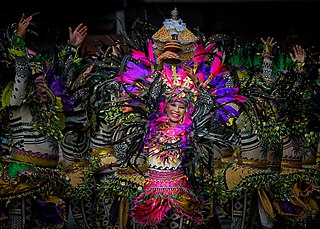
A folk dance is a dance that reflects the life of the people of a certain country or region. Not all ethnic dances are folk dances. For example, ritual dances or dances of ritual origin are not considered to be folk dances. Ritual dances are usually called "religious dances" because of their purpose.

Batangas, officially the Province of Batangas, is a first class province of the Philippines located in the southwestern part of Luzon in the Calabarzon region. Its capital is the city of Batangas, and is bordered by the provinces of Cavite and Laguna to the north, and Quezon to the east. Across the Verde Island Passages to the south is the island of Mindoro and to the west lies the South China Sea. Poetically, Batangas is often referred to by its ancient name, Kumintáng.
The music of the Philippines includes the musical performance arts in the Philippines and the music of Filipinos composed in various local and international genres and styles. Philippine musical compositions are often a mixture of Indigenous styles, and various Asian styles, as well as Spanish/Latin American and (US) American influences through foreign rule from those countries.
The culture of the Philippines is characterized by cultural and ethnic diversity. Although the multiple ethnic groups of the Philippine archipelago have only recently established a shared Filipino national identity, their cultures were all shaped by the geography and history of the region, and by centuries of interaction with neighboring cultures, and colonial powers. In more recent times, Filipino culture has also been influenced through its participation in the global community.

The Sinulog-Santo Niño Festival is an annual cultural and religious festival held on the third Sunday of January in Cebu, with the center of the activities being in Cebu City, and is the centre of the Santo Niño Christian celebrations in the Philippines.

Mangyan is the generic name for the eight Indigenous groups found on the island of Mindoro, southwest of the island of Luzon, each with its own tribal name, language, and customs. The total population may be around 280,001, but official statistics are difficult to determine under the conditions of remote areas, reclusive tribal groups and some having little if any outside world contact.

Cuyo, officially the Municipality of Cuyo, is a 4th class municipality in the province of Palawan, Philippines. According to the 2020 census, it has a population of 23,489 people.

The Obando Fertility Rites are a dance ritual, Anitist in origin, that later became a Catholic festival celebrated every May in Obando, Bulacan, Philippines. Locals and pilgrims, sometimes dressed in traditional costume, dance and sing in the town's streets to honour and beseech Obando's three patron saints: San Pascual, Santa Clara and Nuestra Señora de Salambáo.

Tinikling is a traditional Philippine folk dance which originated prior to Spanish colonialism in the area. The dance involves at least two people beating, tapping, and sliding bamboo poles on the ground and against each other in coordination with one or more dancers who step over and in between the poles in a dance. It is traditionally danced to rondalla music, a sort of serenade played by an ensemble of stringed instruments which originated in Spain during the Middle Ages. The locomotor movements used in this dance are hopping, jumping, and turning.

The traditional music of the Philippines reflects the Philippines' diverse culture, originating from more than 100 ethnolinguistic groups and shaped by a widely varying historical and sociocultural milieu.

The jota is a genre of music and the associated dance known throughout Spain, most likely originating in Aragon. It varies by region, having a characteristic form in Aragon, Mallorca, Catalonia, León, Castile, Navarre, Cantabria, Asturias, Galicia, La Rioja, Murcia and Eastern Andalusia. Being a visual representation, the jota is danced and sung accompanied by castanets, and the interpreters tend to wear regional costumes. In Valencia, the jota was once danced during interment ceremonies.
The arts in the Philippines reflect a range of artistic influences on the country's culture, including indigenous art. Philippine art consists of two branches: traditional and non-traditional art. Each branch is divided into categories and subcategories.
The Philippines is home to several folk dances such as Tinikling, Pandanggo, Cariñosa, and Subli. Dance has integrated itself in Philippine society over the course of many years and is imbedded in Philippine culture.

Holy Week is a significant religious observance in the Philippines for the Catholic majority, the Iglesia Filipina Independiente or the Philippine Independent Church, and most Protestant groups. One of the few majority Christian countries in Asia, Catholics make up 78.8 percent of the country's population, and the Church is one of the country's dominant sociopolitical forces.

Traditional marriage customs in the Philippines and Filipino wedding practices pertain to the characteristics of marriage and wedding traditions established and adhered by them Filipino men and women in the Philippines after a period of adoption courtship and engagement. These traditions extend to other countries around the world where Filipino communities exist. Kasalan is the Filipino word for "wedding", while its root word – kasal – means "marriage". The present-day character of marriages and weddings in the Philippines were primarily influenced by the permutation of Christian, both Catholic and Protestant, Hindu, Islam, Chinese, Spanish, and American models.

Our Lady of the Most Holy Rosary, Queen of the Caracol, known locally as Mahal na Birhen ng Santo Rosaryo, Reyna ng Karakol or Nuestra Señora Virgen del Santissimo Rosario, Reina de Caracol, is the patroness of the Municipality of Rosario, formerly known as Salinas, in Cavite province, Philippines.
Haitian Carnival is a celebration held over several weeks each year leading up to Mardi Gras. Haitian Defile Kanaval is the Haitian Creole name of the main annual Mardi Gras carnival held in Port-au-Prince, Haiti.
Intangible cultural heritage (ICH) includes traditions and living expressions that are passed down from generation to generation within a particular community.
Col. Antonino Ramirez Buenaventura was a Filipino composer, conductor, and teacher.














